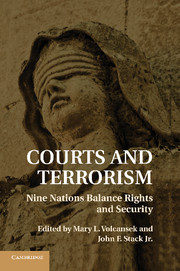Book contents
- Frontmatter
- Contents
- Contributors
- COURTS AND TERRORISM
- Introduction
- 1 Detentions and Security versus Liberty in Times of National Emergency
- 2 One More Casualty of the “War on Terror”
- 3 State Secrets and Democratic Values
- 4 What Lessons Can Be Drawn from a Sui Generis Case? The Global “War on Terror” and Northern Ireland
- 5 The British Experience with Terrorism: From the IRA to Al Qaeda
- 6 Detention and Treatment of Suspected Terrorists under the European Convention on Human Rights
- 7 Australia's Commonwealth Model and Terrorism
- 8 Judicial Rejection as Substantial Relief: The Israeli Supreme Court and the “War on Terror”
- 9 Preserving Rights and Protecting the Public: The Italian Experience
- 10 Squaring the Circle? Fighting Terror while Consolidating Democracy in Spain
- 11 From Exception to Normalcy: Law, the Judiciary, Civil Rights, and Terrorism in Colombia, 1984–2004
- Conclusion: Lessons Learned
- Cases Cited
- Statutes Cited
- References
- Index
Introduction
Published online by Cambridge University Press: 05 July 2011
- Frontmatter
- Contents
- Contributors
- COURTS AND TERRORISM
- Introduction
- 1 Detentions and Security versus Liberty in Times of National Emergency
- 2 One More Casualty of the “War on Terror”
- 3 State Secrets and Democratic Values
- 4 What Lessons Can Be Drawn from a Sui Generis Case? The Global “War on Terror” and Northern Ireland
- 5 The British Experience with Terrorism: From the IRA to Al Qaeda
- 6 Detention and Treatment of Suspected Terrorists under the European Convention on Human Rights
- 7 Australia's Commonwealth Model and Terrorism
- 8 Judicial Rejection as Substantial Relief: The Israeli Supreme Court and the “War on Terror”
- 9 Preserving Rights and Protecting the Public: The Italian Experience
- 10 Squaring the Circle? Fighting Terror while Consolidating Democracy in Spain
- 11 From Exception to Normalcy: Law, the Judiciary, Civil Rights, and Terrorism in Colombia, 1984–2004
- Conclusion: Lessons Learned
- Cases Cited
- Statutes Cited
- References
- Index
Summary
As the twenty-first century dawned, the public in the western world awakened to a new and heightened concern about terrorism as a consequence of the Al Qaeda attacks on the United States on September 11, 2001. Efforts to control and eliminate terrorism inevitably present a conundrum for democratic governance and the rule of law. Indeed, plans for a new U.S. embassy in London unveiled in 2010 can serve as a metaphor of the tensions terrorism introduces into a democracy. The structure, described as architecture serving “as a form of camouflage,” appears more like a fort than a welcoming democratic symbol (Ouroussof, 2010). Must democracies become fort-like entities rather than ones fostering freedom and self-actualization? Although the democratic promise is that liberty and security can be reconciled, how that reconciliation is achieved varies over time and by country.
Courts stand as the fulcrum to achieve a balance between protecting national security successfully and preserving democratic governance. Unfortunately, too often repression is the governmental response to violence, but repression and violence can develop a symbiotic relationship, with “each feeding off the other, in a mutually sustaining fashion” (Campbell and Connolly, 2006: 955). Democratic governance requires adherence to the rule of law, and the rule of law intrinsically entails respect for human rights (Tsoukala, 2006: 615). This book brings together analyses of how courts in the United States and eight other jurisdictions have treated governmental responses to terrorist threats and have balanced violence and repression, rights and security.
- Type
- Chapter
- Information
- Courts and TerrorismNine Nations Balance Rights and Security, pp. 1 - 8Publisher: Cambridge University PressPrint publication year: 2010

